Finnish heavy metal might be about to drop

Last week we saw the market interest rate and inflation expectations fall sharply on the back of central bank rate announcements. The decline was reversed on Friday, 3 February following the robust US employment data. The gap between steel prices and Outokumpu’s share price has widened, providing an argument for selling the Finnish steel stock.
Strong US employment figures send interest rates back up
Equity markets rallied strongly towards the end of last week, supported by a perceived softening in the tone of central bank rate announcements as the Fed, in particular, seems to begin to move closer to the market’s expectation that interest rates will soon peak.
Then, on Friday, 3 February, came robust US employment data, with 517K new jobs created in January 2023. That compares with a consensus forecast of only 188K new jobs. Most new jobs were created in the leisure and hospitality sector (128K), followed by business services (82K), government (74K) and healthcare (58K). The US unemployment rate fell from 3.6% to 3.4%. But wages and salaries in the US rose by only 0.3% in January, to a declining annual rate of 4.4%. That may be explained by the change in the sectors where employment is rising and falling - fewer employees in well-paid jobs at technology companies and more in relatively low-paid service jobs.
The 10-year US Treasury yield stood at 3.56% on Tuesday, 31 January, then fell 19 basis points to 3.37% on Thursday, 2 February, before rising close to its previous level (3.54%) following Friday’s employment report. The Nasdaq fell the most on Friday, 3 February, down 2.2%, followed by the S&P500, down 1.1%, while the Dow Jones declined by just 0.4%.
US 2-year Treasury Yield (in %) from 26 January to 6 February 2023

Reports better than expected, close to business as usual
After another busy week of reporting, 50% of S&P500 companies have reported their Q4 results until 3 February 2023. The number of better-than-expected earnings reports improved slightly to 70% from 69% last week. The number of better-than-expected revenue reports has increased from 60% to 61%. The numbers are starting to stabilise around a slightly weaker result than a typical quarter, where around 75% of S&P500 companies have reported better-than-expected earnings.
The S&P 500 sectors that have managed to beat analysts’ Q4 2022 earnings estimates by the most significant margin are Utilities (100% of the reported company Q4 earnings were better than expected), Health Care (83%) and Information Technology (78%). The worst performers are Financials (64%), Materials (50%) and Commercial Services (36%).
Analysts’ earnings estimates for S&P 500 companies have fallen by 3% for Q1 2023 and 2.5% for FY 2023 between 31 December 2022 and 31 January 2023. As a result, the price/Earnings (P/E) ratio of the S&P 500 index has risen from 16.7x on 31 December 2022 to 18.4x on 31 January 2023. That could limit further share price gains in February 2023.
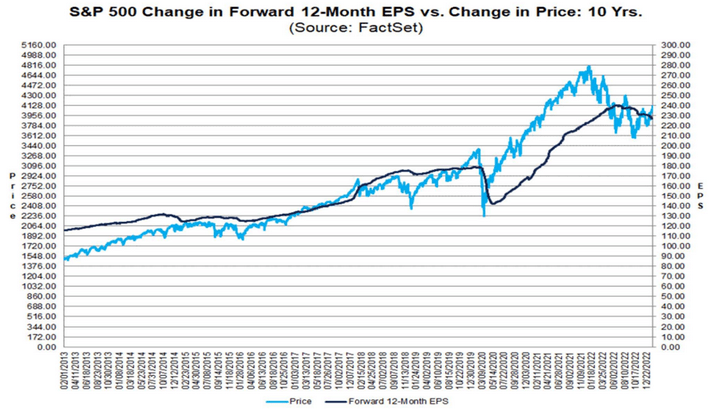
The macroeconomic calendar is pretty thin this week. Equity markets will likely continue to trade on the interpretation of last week’s interest rate announcement, combined with additional economic signals from the Q4 2022 reports due this week. The major S&P 500 companies reporting this week primarily have low cyclicalities, such as Disney, Pepsico, Philip Morris and Coca-Cola.
The short-rising trend is threatened
Overall, we see a high likelihood of a pullback in global equity markets to continue for the rest of this week as the rally in the more interest rate-sensitive sectors may have been too strong in January 2023.
From a technical perspective, S&P 500 is currently trading in a short-term rising trend above MA20. As shown in the chart below, one can see that the index has fallen so far this week and currently testing rising EMA9 – the first test of the short and rising trend. In case of a break, MA20 is the next level, currently at 4,030. However, keep an eye on the interest rates. A pullback in rates may change the sentiment on the stock market.
S&P 500 (in USD), one-year daily chart

In the weekly chart below, MA200, currently at 4208, serves as resistance. On the other hand, rising momentum works in favour of further upside. Thus, short traders should keep an eye on this level.
S&P 500 (in USD), weekly five-year chart
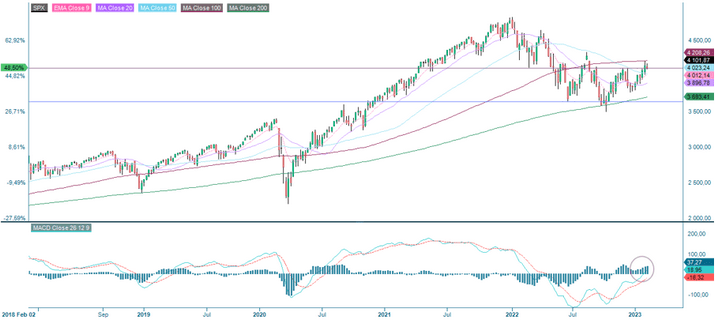
Nasdaq has been stable
As shown in the chart below, the Nasdaq 100 has traded relatively stable this week. The index is currently above both rising EMA9 and MA20. Nasdaq 100 is typically more sensitive to changes in interest rates than the broader S&P 500. Thus, keeping an eye on the interest rates is even more critical when trading Nasdaq.
Nasdaq 100 (in USD), one-year daily chart

Nasdaq 100 (in USD), weekly five-year chart

OMXS30 and DAX in scary-looking formations
Swedish OMXS30 is trading in a scary-looking, sharply rising wedge formation that tends to break on the downside. MA100, currently at 2,146, maybe next in case of a break. Note the negative divergence between MACD and the index.
OMXS30 (in SEK), one-year daily chart
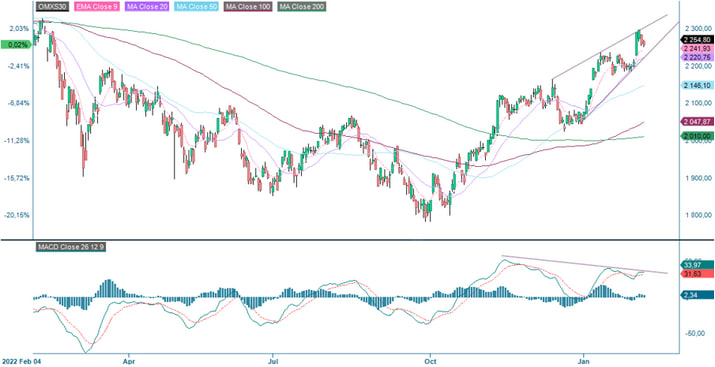
In the weekly chart, momentum is positive and rising, indicating that buying the dips may not be a too bad idea.
OMXS30 (in SEK), weekly five-year chart

As OMXS30, the German DAX is trading in a scary rising wedge formation under negative divergence with MACD.
DAX (in EUR), one-year daily chart
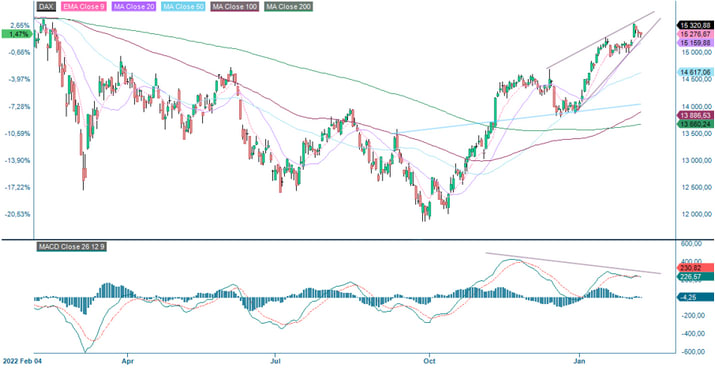
In the weekly chart, momentum is positive and increasing, showing strength in the short trend.
DAX (in EUR), weekly five-year chart
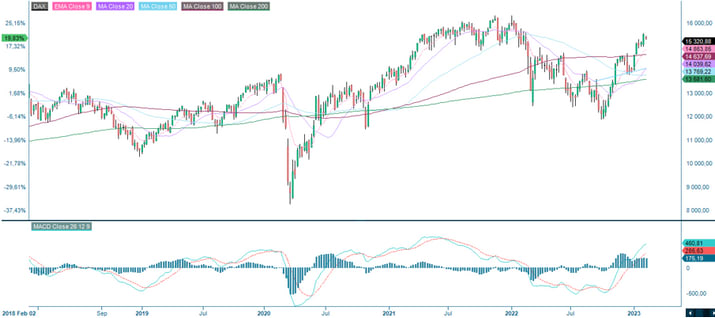
The increase in US rates caused a selloff in gold
The USD has strengthened due to increasing US interest rates. That is negative news for the gold price, which has fallen sharply, currently trading below MA100. Also, note how MACD has generated a weak sell signal. However, Fibonacci 38.2 serves as support around current levels. In case of a break on the downside, levels around 1,820 could be next, where Fibonacci 38.2 and MA100 meet up.
Gold (in USD per ounce), one-year daily chart

In the weekly chart, momentum is still positive but fading, as illustrated by the falling MACD.
Gold (in USD per ounce), weekly five-year chart
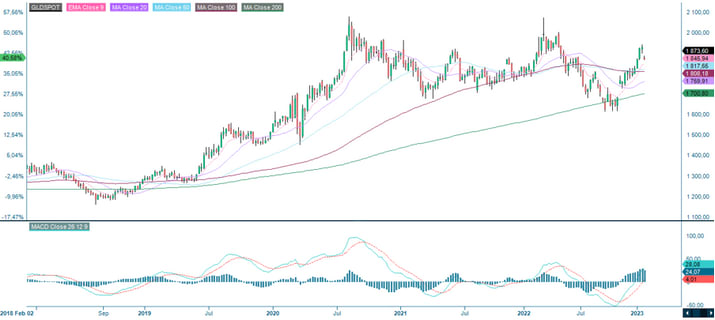
Finnish heavy metal might be about to drop
Steel prices have been squeezed following the war in Ukraine, rising energy and input costs and China’s lockdown. Outokumpu will release its Q4 2022 report on February 9. The Finnish company has not been popular with analysts since the beginning of 2023. Given two neutral and three sell recommendations, expectations of the Finnish steel giant reflect the current uncertainty in stainless steel and related steel product prices.
Like many other raw material stocks, the Outokumpu share saw excellent performance during 2021, highly correlated with market prices on steel rebar and hot-rolled coil steel (HRC-steel). As material prices peaked in Q3 2021 and started to fall fast, the share price became less correlated. Following a choppy 2022, where the share struggled despite the company beating EPS consensus estimates in Q1-Q3 and with a significant divestment of the Long Products business, 2023 has been good. The share is up over 7 % at the time of writing, possibly reflecting expectations of lower-than-anticipated energy prices.
HLSE: OUT1V (EUR) vs Steel rebar futures (CNY per tonne) vs Hot-Rolled Coil steel (USD/T) daily five-year share price chart
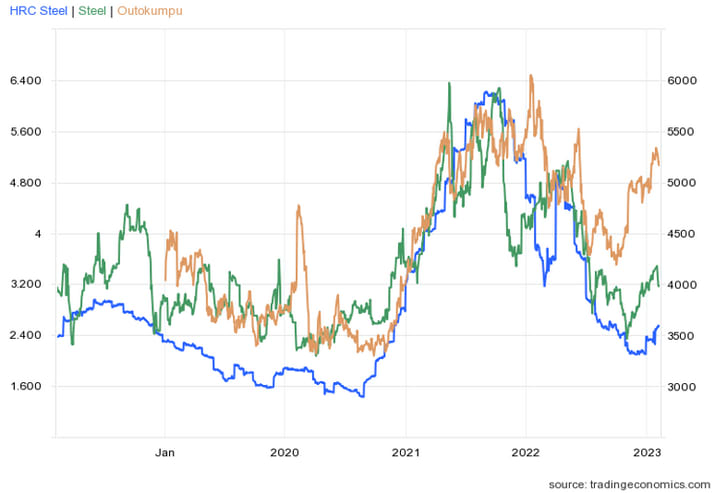
Worth noting here however is that even though Outokumpu specializes in stainless steel, the material shares enough extrinsic variables with steel rebar to be correlated to such an extent as to where the comparison is relevant. In tandem with a positive share price development in 2023, the gap between share price and steel rebar prices has widened. That is particularly prominent as the Outokumpu share trades at lower multiples than other sector colleagues, hinting at more significant exposure to external material prices.
Additional clouds on the horizon appeared in the form of demand woes from one of China’s biggest importers, as the economy’s reopening has gone slower than expected. Given all the above, a downward trend for the share price might be in the cards.
From a technical perspective, Outokompu is trading in a short and rising trend but below EMA9 and MA20. A negative divergence between the share price and MACD is also visible.
Outokumpu OYJ (in EUR) daily one-year share price chart

In the weekly chart, converging EMA9 and MA100 is the resistance between 4.95 and 5.00 EUR.
Outokumpu OYJ (EUR) weekly five-year share price chart
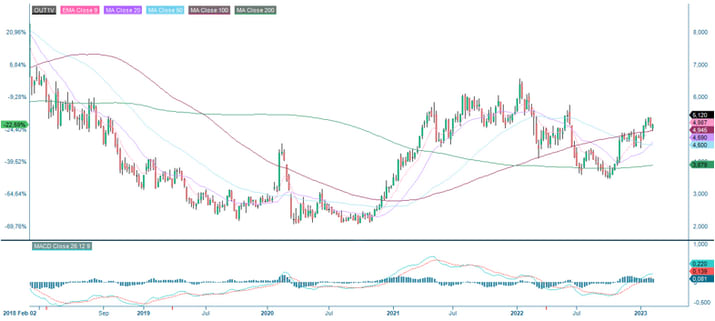
The full name for abbreviations used in the previous text:
EMA 9: 9-day exponential moving average
Fibonacci: There are several Fibonacci lines used in technical analysis. Fibonacci numbers are a sequence of numbers in which each successive number is the sum of the two previous numbers.
MA20: 20-day moving average
MA50: 50-day moving average
MA100: 100-day moving average
MA200: 200-day moving average
MACD: Moving average convergence divergence
Risks
External author:
This information is in the sole responsibility of the guest author and does not necessarily represent the opinion of Bank Vontobel Europe AG or any other company of the Vontobel Group. The further development of the index or a company as well as its share price depends on a large number of company-, group- and sector-specific as well as economic factors. When forming his investment decision, each investor must take into account the risk of price losses. Please note that investing in these products will not generate ongoing income.
The products are not capital protected, in the worst case a total loss of the invested capital is possible. In the event of insolvency of the issuer and the guarantor, the investor bears the risk of a total loss of his investment. In any case, investors should note that past performance and / or analysts' opinions are no adequate indicator of future performance. The performance of the underlyings depends on a variety of economic, entrepreneurial and political factors that should be taken into account in the formation of a market expectation.
Disclaimer:
This information is neither an investment advice nor an investment or investment strategy recommendation, but advertisement. The complete information on the trading products (securities) mentioned herein, in particular the structure and risks associated with an investment, are described in the base prospectus, together with any supplements, as well as the final terms. The base prospectus and final terms constitute the solely binding sales documents for the securities and are available under the product links. It is recommended that potential investors read these documents before making any investment decision. The documents and the key information document are published on the website of the issuer, Vontobel Financial Products GmbH, Bockenheimer Landstrasse 24, 60323 Frankfurt am Main, Germany, on prospectus.vontobel.com and are available from the issuer free of charge. The approval of the prospectus should not be understood as an endorsement of the securities. The securities are products that are not simple and may be difficult to understand. This information includes or relates to figures of past performance. Past performance is not a reliable indicator of future performance.
© Bank Vontobel Europe AG and/or its affiliates. All rights reserved.
